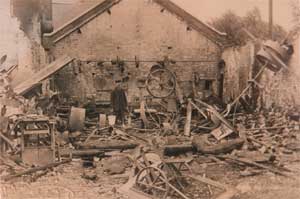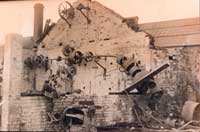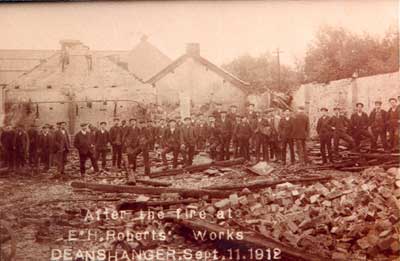|
 |
 |
 |
 |
 |
|
|
 |
|
 |
|
At ten minutes past nine on Wednesday 11th September 1912, Reg Cannin and Thomas Strutton were returning from a walk to their homes in Deanshanger. As they were crossing the canal, they looked over to the works where they saw a flicker of light, rapidly becoming larger as the flames leapt through the carpenters shop. They immediately went to the keyholders house, Mr. Barry Nichols, and on their return found the flames spreading through the shavings on the floor, the wooden trestle wheels and the rafters in the ceiling. |
|
 |
|
 |
|
 |
|
The alarm quickly spread with villagers and workmen rushing to the scene, trying to salvage as much as possible from the paint and wheelwrights shops.
Mr. Tom Roberts had been notified by telephone whilst Mr. Archie Roberts rode swiftly on horseback to Stony Stratford for the fire brigade.
While waiting for the fire brigade to arrive, a group of people carried water from the canal in all the available buckets in an attempt to stop the flames. |
|
 |
|
 |
|
 |
|
Some of the group climbed onto the roof to soak the burning rafter although they were soon beaten back by the heat and smoke. A group of six cottages behind the moulding shop adjoining the wheelwrights were also threatened by the fire and volunteers helped the cottagers to carry their furniture and valuables to safety.
At 9.30, the Stony Stratford fire brigade appeared on the scene. Their first duty was to try and prevent the flames reaching the huge tanks of oil and petrol to the right of the paintshop. The firemen cut a hole in the hedge bordering the canal, ran through the pump connected to a hosepipe which enabled a steady stream of water to be poured on the flames. Their commendable efforts were in vain though because the building soon became a mass of flames.
|
|
 |
|
 |
|
 |
|
A few minutes before 9.30, the people in the streets of Wolverton had noticed a strange glow in the sky. Moments later, the fire alarm sounded at Wolverton Works and the splendidly trained Wolverton Works Fire Brigade were quickly on their way travelling at speed behind two powerful black horses. Although it was quite late in the evening, thousands of people travelled the four miles from Wolverton and the surrounding villages to watch the blaze. The horses made the journey in record time with the Chief Officer following on his motorcycle.
Both brigades soon had a heavy stream of water pouring on the flames. The roof collapsed and the flames subsided for a few moments, only to burn through again up the walls. With tremendous effort, the brigade managed to drive the flames away from the oil tanks and confined them to the three shops.
|
|
 |
|
 |
|
 |
|
A group of Wolverton firemen had a lucky escape when a wall collapsed just feet from where they were holding the hose, however one officer was not quite so lucky when he turned sharply and landed in the canal. He climbed out with great difficulty due to the weight of his soaking wet uniform.
The fire “was something of a blessing in disguise, for as a result everything was modernised, not only the buildings but also the machinery” B. Case.
Return to Ironworks: Contents Page |
|




